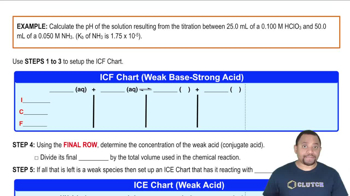A 30.0-mL sample of 0.165 M propanoic acid is titrated with 0.300 M KOH. Calculate the pH at each volume of added base: 20 mL.
Ch.17 - Aqueous Ionic Equilibrium

Chapter 17, Problem 73b
Consider the titration of a 25.0-mL sample of 0.175 M CH3NH2 with 0.150 M HBr. Determine each quantity: b. the volume of added acid required to reach the equivalence point, d. the pH at one-half of the equivalence point, f. the pH after adding 5.0 mL of acid beyond the equivalence point.
 Verified step by step guidance
Verified step by step guidance1
b. Volume of added acid required to reach the equivalence point:
1. Write the balanced chemical equation for the reaction: \( \text{CH}_3\text{NH}_2 + \text{HBr} \rightarrow \text{CH}_3\text{NH}_3^+ + \text{Br}^- \).
2. Calculate the moles of \( \text{CH}_3\text{NH}_2 \) in the initial solution: \( \text{moles} = \text{volume (L)} \times \text{molarity} \).
3. Use the stoichiometry of the reaction to determine the moles of \( \text{HBr} \) needed, which is equal to the moles of \( \text{CH}_3\text{NH}_2 \) since the reaction is 1:1.
4. Calculate the volume of \( \text{HBr} \) solution required using its molarity: \( \text{volume (L)} = \frac{\text{moles of HBr}}{\text{molarity of HBr}} \).
d. pH at one-half of the equivalence point:
1. At one-half of the equivalence point, the concentration of \( \text{CH}_3\text{NH}_2 \) equals the concentration of \( \text{CH}_3\text{NH}_3^+ \).
2. Use the Henderson-Hasselbalch equation: \( \text{pH} = \text{pK}_a + \log\left(\frac{[\text{base}]}{[\text{acid}]}\right) \).
3. Since \([\text{base}] = [\text{acid}]\), \( \log\left(\frac{[\text{base}]}{[\text{acid}]}\right) = 0 \), so \( \text{pH} = \text{pK}_a \).
4. Calculate \( \text{pK}_a \) from \( \text{pK}_w = 14 \) and \( \text{pK}_b \) of \( \text{CH}_3\text{NH}_2 \): \( \text{pK}_a = 14 - \text{pK}_b \).
f. pH after adding 5.0 mL of acid beyond the equivalence point:
1. Calculate the total volume of \( \text{HBr} \) added: \( \text{volume at equivalence point} + 5.0 \text{ mL} \).
2. Determine the moles of excess \( \text{HBr} \) added beyond the equivalence point.
3. Calculate the concentration of excess \( \text{H}^+ \) ions in the total solution volume.
4. Use the concentration of \( \text{H}^+ \) to find the pH: \( \text{pH} = -\log[\text{H}^+] \).
Key Concepts
Here are the essential concepts you must grasp in order to answer the question correctly.
Titration and Equivalence Point
Titration is a quantitative analytical method used to determine the concentration of a solute in a solution. The equivalence point occurs when the amount of titrant added is stoichiometrically equivalent to the amount of substance in the sample. In this case, it is where the moles of HBr added equal the moles of CH3NH2 present, allowing for the calculation of the volume of acid needed.
Recommended video:
Guided course

Equivalence Point in Titration
pH and Buffer Solutions
pH is a measure of the acidity or basicity of a solution, defined as the negative logarithm of the hydrogen ion concentration. At one-half of the equivalence point in a titration of a weak base with a strong acid, the solution acts as a buffer, where the concentrations of the weak base and its conjugate acid are equal, resulting in a pH that can be calculated using the pKa of the weak base.
Recommended video:
Guided course

Buffer Solutions
Post-Equivalence Point pH
After the equivalence point in a titration, the solution contains excess strong acid, which significantly influences the pH. The pH can be calculated by determining the concentration of the excess HBr in the solution after adding a specific volume of acid beyond the equivalence point. This results in a lower pH, reflecting the increased acidity of the solution.
Recommended video:
Guided course

pH at the Equivalence Point Example
Related Practice
Textbook Question
352
views
Textbook Question
A 30.0-mL sample of 0.165 M propanoic acid is titrated with 0.300 M KOH. Calculate the pH at each volume of added base: 25 mL.
367
views
Textbook Question
Consider the titration of a 25.0-mL sample of 0.175 M CH3NH2 with 0.150 M HBr. Determine each quantity. a. the initial pH
632
views
Textbook Question
Consider the titration of a 25.0-mL sample of 0.175 M CH3NH2 with 0.150 M HBr. Determine each quantity. c. the pH at 5.0 mL of added acid
3117
views
Textbook Question
Consider the titration of a 25.0-mL sample of 0.175 M CH3NH2 with 0.150 M HBr. Determine each quantity. e. the pH at the equivalence point
588
views
Textbook Question
A 25.0-mL sample of 0.125 M pyridine is titrated with 0.100 M HCl. Calculate the pH at each volume of added acid: 0 mL.
330
views
